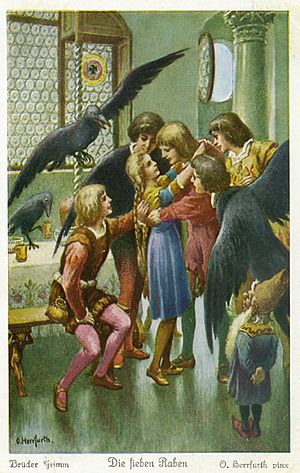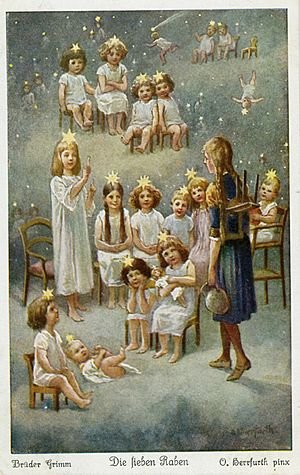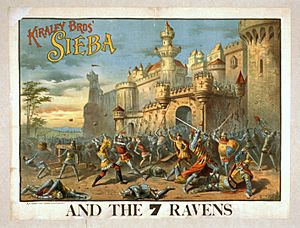The Seven Ravens facts for kids
Quick facts for kids The Seven Ravens |
|
|---|---|

The sister meets her brothers.
|
|
| Folk tale | |
| Name | The Seven Ravens |
| Data | |
| Aarne–Thompson grouping | ATU 451 |
| Country | Germany |
| Published in | Grimm's Fairy Tales |
"The Seven Ravens" (German: Die sieben Raben) is a classic German fairy tale. It was collected by the famous Brothers Grimm. This story is about a girl who searches for her seven brothers. They were accidentally turned into ravens. This type of tale, where brothers become birds, is common in many European stories.
Other similar fairy tales include The Six Swans and The Wild Swans. There is also The Twelve Wild Ducks and The Twelve Brothers. These stories often share a common theme of a sister saving her enchanted brothers.
An animated movie based on this story was released in 1937. You can find out more about it under The Seven Ravens.
How the Story Began
The Brothers Grimm first published this tale in 1812. It was part of their book called Kinder- und Hausmärchen. In its first version, the story was known as "The Three Ravens."
Later, in 1819, they changed the title to Die sieben Raben. They also rewrote much of the story. The Grimms heard this tale from the Hassenpflug family and other people.
The Story of the Seven Ravens
The story begins with a farmer who has seven sons. He really wants a daughter. Finally, a baby girl is born, but she is very sick. The father sends his sons to get water for her. In the German version, this water is for her baptism. In a Greek version, it is from a special healing spring.
The sons rush to get the water. But in their hurry, they drop the jug into the well. When they do not come back, their father gets angry. He thinks they are playing instead of helping. He curses them, and because of his words, the seven sons turn into ravens.
Years later, the sister grows up. She learns about her brothers and decides to find them. She wants to break the curse. Her journey is long and difficult.
She first tries to get help from the sun, but it is too hot. Then she asks the moon, but it seems scary. Finally, she finds the morning star. The star helps her by giving her a special item. In the German story, it is a chicken bone. In the Greek version, it is a bat's foot. The star tells her she will need this item to save her brothers.
The sister eventually finds her brothers on a mysterious Glass Mountain. To get inside, she needs a key. In the Greek version, she uses the bat's foot. In the German story, she has lost the bone. So, she bravely cuts off one of her own fingers to use as a key.
Inside the mountain, she meets a dwarf. He tells her that her brothers will return soon. While waiting, she takes some of their food and drink. She leaves a special ring from home in the last cup.
When her brothers return, they turn back into human form. They notice that someone has been eating their food. The youngest brother finds the ring. He realizes it must be their sister. He hopes this means they are saved. The sister then comes out of her hiding place. They are all very happy and return home together.
The Story in Music
This fairy tale has inspired many musical works. A Liechtenstein composer named Josef Rheinberger wrote an opera based on the story. It was first performed in 1867.
Later, Ludwig Englander created a big stage show called The Seven Ravens. It combined drama, pantomime, opera, and ballet. The story for this show was based on a German play by Emil Pohl. It opened in New York in 1884 and was very popular.
Around the same time, the Kiralfy Brothers also put on a competing show. Their production was called Sieba and the Seven Ravens. It was presented at the Star Theatre.



